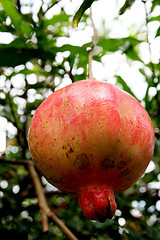Difference between revisions of "Pomegranates"
m (→Harvesting and handling) |
|||
| Line 20: | Line 20: | ||
Pomegranates can be grown in tropical to warm temperate climates. However, the best quality pomegranate fruits are produced in regions with cool winters and hot, dry summers. Few areas are too hot and the pomegranate is more cold hardy (receives less damage) than citrus. The pomegranate is non-climacteric and can be left on the tree for some time after reaching maturity. | Pomegranates can be grown in tropical to warm temperate climates. However, the best quality pomegranate fruits are produced in regions with cool winters and hot, dry summers. Few areas are too hot and the pomegranate is more cold hardy (receives less damage) than citrus. The pomegranate is non-climacteric and can be left on the tree for some time after reaching maturity. | ||
<br><br> | <br><br> | ||
| − | + | Fruit quality depends largely on [[sugar]] and acid content of the juice. A high quality pomegranate should also have an attractive skin, small [[seeds]] in the aril; and should be free from sunburn, growth cracks, cuts, bruises, and decay. Skin colour and smoothness are other quality indices. Sour and sour-sweet pomegranates have reddish skin, in contrast to sweet pomegranates, which have yellowish-green skin. | |
==Cooling and storage== | ==Cooling and storage== | ||
Revision as of 16:56, 14 January 2021
| Infobox on Pomegranates | |
|---|---|
| Example of Pomegranates |  |
| Freshness facts | |
| Optimum carrying temperature | 5°C for up to 2 months; longer storage should be at 7.2°C to avoid chilling injury |
| Highest freezing point | -3°C |
| Acceptable product temp. at loading into containers | Max. 5°C above carrying temperature |
| Optimum humidity | 90%-95% |
| Ventilation setting for containers | 10 m³/hr |
| Storage life | 2-3 months |
| Climacteric / non-climacteric | Non-climacteric |
| Ethylene production | Low |
| Ethylene sensitivity | Low |
| Modified / controlled atmosphere | 5%-10% CO2; 3%-5% O2 |
| Potential benefits | Good |
| Availability | |
| South America Israel Turkey |
January - April August - October August - February |
Pomegranates
Contents
Harvesting and handling
Pomegranates are yellow-green, brownish-yellow to purplish-red berries 5 - 12 cm in diameter with a smooth, leathery skin. Fruits are spherical, somewhat flattened, with a persistent calyx. The calyx may be 1-6 cm long. Numerous seeds are each surrounded by a pink to purplish-red, juicy, sub-acid pulp (arils) which is the edible portion. The pulp is somewhat astringent.
Pomegranates can be grown in tropical to warm temperate climates. However, the best quality pomegranate fruits are produced in regions with cool winters and hot, dry summers. Few areas are too hot and the pomegranate is more cold hardy (receives less damage) than citrus. The pomegranate is non-climacteric and can be left on the tree for some time after reaching maturity.
Fruit quality depends largely on sugar and acid content of the juice. A high quality pomegranate should also have an attractive skin, small seeds in the aril; and should be free from sunburn, growth cracks, cuts, bruises, and decay. Skin colour and smoothness are other quality indices. Sour and sour-sweet pomegranates have reddish skin, in contrast to sweet pomegranates, which have yellowish-green skin.
Cooling and storage
Harvested fruits have a low rate of respiration and of ethylene production. They are prone to moisture loss and should be stored at high humidity; this may be achieved by the use of polyethylene lined cartons. Chilling injury occurs if pomegranates are exposed for longer than one month at temperatures between their freezing point -3 °C and 5°C or longer than two months at 5° C. External symptoms include brown discoloration of the skin and increased susceptibility to decay. Internal symptoms include a pale colour of the arils (pulp around the seeds) and brown discoloration of the white segments separating the arils.
Internal breakdown is another physiological disorder in pomegranate fruit in which the pulp-bearing seeds (arils) do not develop their typical red colour and are somewhat flattened rather than plump.
CA conditions
Very few studies of the responses of pomegranates to CA have been conducted. Storage in 2% O2 reduces chilling injury if pomegranates are kept below 5°C. In one study, pomegranates were stored successfully at 6°C in 3% O2 + 6% CO2 atmosphere for 6 months. In another study a combination of 5% O2 + 15% CO2 was found to be effective in decay control and scald prevention for up to 5 months at 7°C.
Cautions
Pomegranates are very susceptible to water loss resulting in shrivelling of the skins. Storing fruit in plastic liners and waxing can reduce water loss, especially under conditions of lower relative humidity.
Storage disorders
Anthracnose, Aspergillus rot, Chilling injury, Coniella rot, Scald











